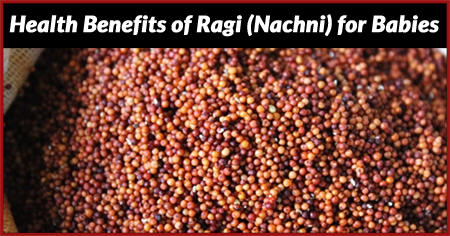 Ragi or Nachni is one of the immune boosting super-foods for babies and growing children. Read on to learn more about the health benefits of ragi for babies.
Ragi or Nachni is one of the immune boosting super-foods for babies and growing children. Read on to learn more about the health benefits of ragi for babies.Ragi is not only beneficial for growing children but also can provide innumerable health benefits to adults. Ragi (Nachni), otherwise called as finger millet is one of the best and vital cereals that lodge the maximum zone under agriculture among the minor millets. As a whole grain, ragi has a huge protein and mineral content when compared to many other cereals.
Feeding babies with ragi porridge on a regular basis can help to improve their overall immunity and growth.
It serves to be a good vegetarian product due to its remarkable nutritious and healthy content. Leucine, phenyl alanine, methionine and isoleucine are some of the important amino acid content present in finger millet, which cannot be seen in any other solemn meals. Homemade ragi powder is one of the vital nutritious
foods given to most of the babies from sixth month onwards. Instead of store bought powders, it is best suggested to prepare at home. Make sure that you consult a pediatrician before including ragi in the
diet of your baby.
Nourishing Benefits of Ragi for Babies
Let us take a look at the health benefits of ragi for babies.
Storehouse of Natural Iron and Calcium
None of the other cereals come close to ragi when talking about the calcium and iron content. It is a well-known fact that calcium plays a vital role in bone development and preclusion of diseases like osteoporosis and anemia. Instead of calcium and iron drops for babies, it is best advised to replace with ragi porridge which would be a good diet as well.
Other Health Benefits of Ragi
Ragi is a good stomach filling food for babies. Few other important health benefits of ragi for babies are listed below:
- Useful during teething years as it has good quantity of calcium and amino acid threonine.
- Boosts immunity power and sinks the hurtful cholesterol level.
- Due to the presence of amino acid tryptophan, babies become emotionally agile and it also aids in killing the anxiety and depression feelings.
- Iron content supports blood formation and prevents iron deficiency diseases.
- Persuades release of growth hormones.
- Gives healthy skin and hair due to the presence of amino acid methionine.
- Aids in controlling blood sugar.
Have a quick look at the different form in which ragi can be included in the diet of babies.
1. Ragi Malt
Malt can be made by soaking ragi for few hours in water. Grind this soaked ragi by adding some water for extracting the juice. Once this juice is extracted it can be mixed with milk and cooked. A little sugar or jaggery can be added to it to add taste. After it is cooked the consistency will improve. More milk can be added to it to make it tastier for babies.
2. Ragi Porridge
Soak ragi for few hours, drain all the water completely and sun-dry it. Roast it in ghee and grind it into fine powder. Store this power in air-tight container. When you want to make ragi porridge for your child, take a bowl of milk or water, add few spoons of ragi powder to it, add
sugar or jaggery for taste, mix it well and cook it well till it comes to boil. Once it cools down feed it to your baby.
There are a few other recipes available for older kids prepared with ragi like ragi paratha, ragi pudding, ragi ambli, ragi idli & dosa, ragi almond cookies and ragi puttu. Most of the pediatricians prescribe ragi to
lactating mothers in order to increase the breast milk supply and improve its quality so that right nourishment is provided to the baby.
What are the benefits of including ragi in the diet of babies? How to include ragi in the diet of babies? Are there any side-effects of including ragi in the diet of babies? Discuss here.


